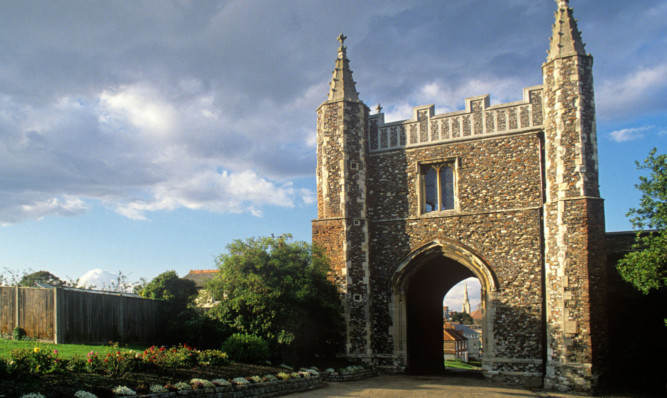
The seat of empire.
As the Norwich-bound train curves into Colchester after crossing much of the flat plain of Essex, you look out of the window and might well be surprised to see a significantly high hill.
Even from a distance, there are a pair of distinctive monuments on the heights.
One seems to be made of brick, the other of stone and both look intriguing.
The latter is Colchester’s imposing Town Hall and the brick one is affectionately known as “Jumbo”. But more of Jumbo later.
Colchester, on the northern border of Essex, dances a jolly jig in claiming to be the oldest recorded town in Britain it was mentioned by Pliny the Elder and he died in AD75!
Before the Romans invaded it was ruled by Cunobelin, who must have wielded considerable power in these parts, because coins minted during his time in charge have popped up in hoards all over East Anglia and even further afield.
Shakespeare wrote about him, calling him Cymbeline, and he is very likely to have been the Old King Cole who was the Merry Old Soul of nursery rhyme fame.
Come the Romans and Emperor Claudius, the town moved from the area around the River Colne up to the top of that hill, where they dug in and built fortifications. They called it Camulodunum and made the place their English capital.
Not everyone welcomed European integration (what’s changed?) and in AD 60 there was an uprising of the tribes, led by the formidable Boudicea who burned the Roman buildings to the ground.
The town was rebuilt, more splendidly, and only recently the site of one the largest Roman chariot racing tracks of their empire was discovered underneath an old Army barracks.
Colchester has been a garrison town, of sorts, for nearly 2,000 years, and today’s Army is still very much part of the local economy.
The track has ruts the chariot wheels scoured into the stones all those years ago. It’s probably not advisable to do so, but it’s said that if you pull up any paving stone in these parts you’ll likely find something of historical interest below.
Another Roman link is the lady we know now as Saint Helena, who may have been (but probably wasn’t) the daughter of King Cole, but who definitely was the mother of Constantine, the only Roman Emperor to have been proclaimed on these islands, in York.
She was a feisty old mare, by all accounts, and something of a traveller because, having converted to Christianity, she set off around the Middle East to find relics of Christ’s life.
It is because of Helena that fragments of the cross on which it is said Christ was crucified are held in Rome and the Holy Robe of Jesus is on display in the Cathedral of Trier, western Germany.
She’s Colchester’s Patron Saint and there are numerous things named after her. She’s also remembered on the town’s beautiful coat of arms, which features a red background (for the blood shed at the crucifixion), a cross, three crowns and nails.
Environmentalists may be interested to note that Colchester is a place where recycling is embraced it has been going on here for two millennia.
Everywhere you discover Roman bricks and Norman stone bunged into another “new wall”, and the castle is a fine example.
A visit is a must and you can take part in virtual chariot racing, son et lumiere shows and see exhibitions of the town’s past in the recently constructed interpretative centre.
The Normans built a stone keep (designed by Gundulf, Bishop of Rochester, the same fellow who later gave us the central White Tower of the Tower of London) and into the fabric are woven layers of ancient bricks.
They appear in all sorts of places, from churches to pubs, and the craftsmen who made them would have been amazed at the longevity and durability of their work.
But there’s a sort of tradition of that here. The North Hill Hotel, for example, may appear to be Georgian or very early Victorian from the front, but waking up in the morning I was looking at a medieval beamed ceiling new had been added and extended to the older. It happens time and time again. Knocking something down is just not accepted in Colchester.
The Roundhead commander, General Sir Thomas Fairfax, with his Parliamentarian army, laid siege to the town during the Civil War and, after many months, finally took the town.
He ordered the execution of the two Royalist leaders within the walls, Sir Charles Lucas and Sir George Lisle, who were taken from the castle to the nearby ramparts, and shot.
Here’s a “surprise around every corner” town with much to enjoy and admire.
It has one of the most beautiful and most-loved parks anywhere in the UK, and a bandstand which, in summer, is alive with music and performance.
And overlooking it all, there’s Jumbo, a giant water-tower, constructed in the later years of Victoria’s reign.
It is a splendid piece of engineering, and, dare I say it, a bit of a joke, out of place and out of keeping.
The nickname comes from the story that, at the same time the eyesore was going up, London Zoo were attempting to sell Jumbo, their popular elephant, to PT Barnum’s travelling circus.
A local clergyman wrote to the press saying the zoo’s parting with their Jumbo was equally as scandalous and inappropriate as Colchester’s new water tower.
The name stuck. It’s a completely daft, beautifully bonkers building. But it makes you smile.
Report by Phil Penfold

Enjoy the convenience of having The Sunday Post delivered as a digital ePaper straight to your smartphone, tablet or computer.
Subscribe for only £5.49 a month and enjoy all the benefits of the printed paper as a digital replica.
Subscribe